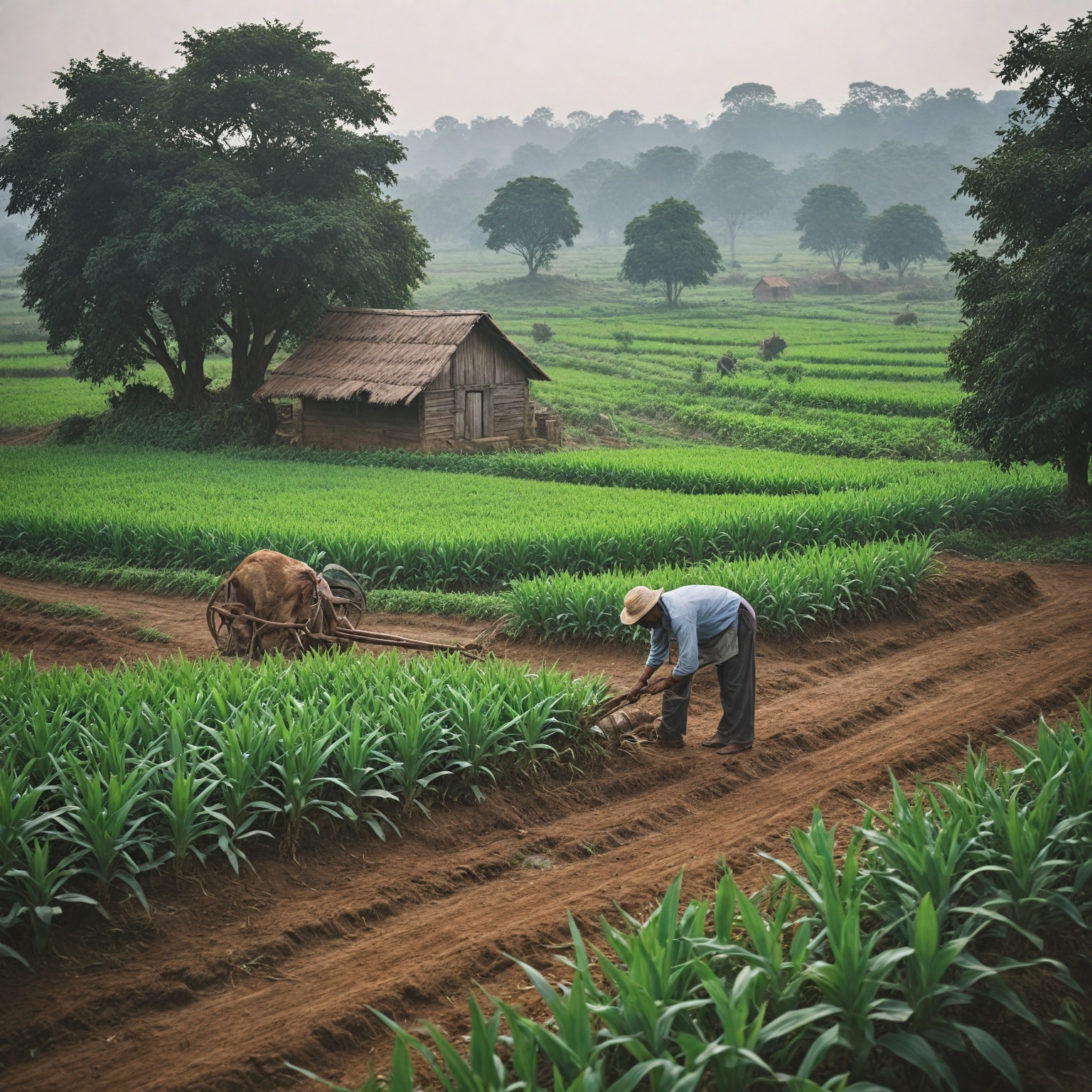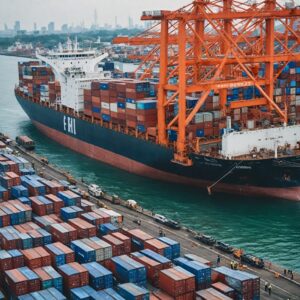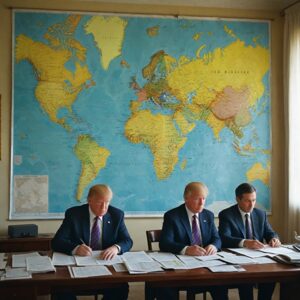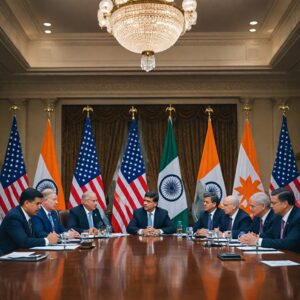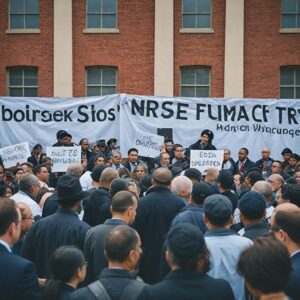Summary
The nationwide farmers’ protest on August 13, 2025, organized by the coalition CTUs-SKM—comprising ten Central Trade Unions and the Samyukt Kisan Morcha—represented a significant chapter in the ongoing struggle of Indian agricultural and labor communities against policies perceived to threaten their livelihoods and national sovereignty. This large-scale mobilization brought together farmers, workers, students, and citizens across the country to oppose international trade agreements, such as the India-UK Comprehensive Economic Trade Agreement (CETA) and recent tariff threats from the United States, which organizers argued would undermine India’s agricultural sector and food security. The protest combined diverse forms of mass action including rallies, tractor and motorcycle marches, and public demonstrations, reflecting broad-based resistance to both domestic reforms and global economic pressures.
The roots of this movement trace back to the contentious agricultural laws passed by the Indian Parliament in 2020, which sparked historic protests primarily in northern India and drew the support of over 200 farmer organizations. These laws were widely criticized by farmers as favoring corporate interests over smallholders and threatening traditional systems such as the minimum support price (MSP) and regulated mandis (markets). Although the government repealed these laws in 2021 following prolonged demonstrations, concerns about the impact of international trade agreements and economic policies on farmers’ livelihoods persisted, motivating renewed collective action.
The protest garnered widespread attention both domestically and internationally, highlighting complex issues including food security, economic sovereignty, and democratic oversight of trade negotiations. The movement also faced significant challenges, including confrontations with law enforcement, restrictions on protest activities, and internal political debates. High-profile incidents of police violence and government-imposed security measures intensified public scrutiny and political discourse around the rights of farmers and the role of the state in managing dissent.
The August 13 protest thus stands as a pivotal moment within a broader continuum of agrarian unrest in India and beyond, reflecting farmers’ persistent demands for economic justice, transparent policymaking, and protection from perceived exploitative trade practices. Its legacy includes strengthened solidarity among agricultural and labor groups, increased international awareness of India’s agrarian challenges, and ongoing negotiations aimed at securing sustainable futures for farming communities amid global economic shifts.
Background
The nationwide farmers’ protest that culminated on August 13 was part of a broader wave of agrarian unrest unfolding across multiple countries, with India and several European nations witnessing significant movements since 2021. The origins of the protest in India trace back to the passage of three agricultural laws by the Indian Parliament in September 2020, which farmers and numerous unions criticized as detrimental to their livelihoods, describing them as “anti-farmer laws”. The legislation sparked widespread opposition, resulting in historic protests centered around Delhi and attracting support from over 200 farmers’ organizations.
The Indian farmers’ protests became notable not only for their scale but also for the complex narratives and tensions surrounding them. At the protest sites near the Singhu border between Haryana and Delhi, various conspiracy theories circulated, including claims that the COVID-19 pandemic was a government ploy to disband the protests through social distancing mandates. In response to concerns about security and possible provocations, protestors installed multiple CCTV cameras to monitor the camps. The movement witnessed moments of police violence, exemplified by widely circulated images of confrontations, such as that of a paramilitary officer reportedly assaulting an elderly Sikh farmer, which further galvanized public opinion and political debate.
The protest movement was marked by significant hardships, including harsh weather conditions and health crises that led to several fatalities among the protestors. These losses became powerful symbols of the farmers’ sacrifices and amplified their demands for the repeal of the contentious laws. After prolonged demonstrations, the Indian government announced the repeal of the three farm laws in November 2021, following Prime Minister Narendra Modi’s declaration to revoke the legislation.
Parallel to India, other countries have experienced similar farmer-led protests, often linked to concerns about agricultural policies, trade agreements, and ecological issues. For instance, in the United Kingdom, new laws proposed in the October 2024 budget by the Labour government spurred thousands of farmers to protest, including demonstrations in Parliament Square and direct engagements with lawmakers. In Italy, farmer groups have expressed concerns over issues such as debt, pesticide use, and the impact of free trade and imports on local agriculture, reflecting a complex mix of anti-ecological demands and progressive calls for limiting supply chains.
Public perception of such protests has varied, with some surveys indicating support for less disruptive forms of protest like peaceful demonstrations and symbolic gestures, while understanding and approval for more sustained or disruptive actions have fluctuated over time. The global nature of these protests underscores shared grievances among farmers worldwide, centered on protecting agricultural livelihoods in the face of legislative, economic, and environmental challenges.
Organization of the August 13 Protest
The nationwide protest scheduled for August 13, 2025, was organized by a coalition known as CTUs-SKM, a joint platform comprising ten central trade unions and the Samyukt Kisan Morcha (SKM). This coalition called upon farmers, workers, students, and patriotic citizens to participate in various forms of mass action, including tractor and motorcycle rallies, protest demonstrations, and public gatherings. The specifics of these actions were left to be decided by the different platforms and partner organizations involved in the coalition.
The formation of this coalition reflects a broader strategy of cooperation among diverse groups to achieve common goals. Coalitions like CTUs-SKM unite members from different sectors—such as labor unions and farmers’ organizations—to increase collective bargaining power and political influence. While coalitions face challenges such as internal competition and the need to navigate shared governance and funding, they serve as effective platforms for collective decision-making and coordinated activism.
Decision-making within such coalitions generally follows consensus or majority rule to ensure that members feel represented and committed to collective actions. Consensus-based decision-making, though more time-consuming, fosters higher group cohesion and stronger support for the coalition’s initiatives, which is crucial in large-scale protests involving multiple stakeholders.
The Samyukta Kisan Morcha, a non-political body claiming to represent over 150 farmer organizations, alongside the Kisan Mazdoor Morcha, which includes about 100 farmers’ unions, played a leading role in mobilizing participants for the protest. These groups have a history of organizing significant demonstrations, including the notable ‘Delhi Chalo’ march, and have criticized the government for failing to fulfill promises related to farmers’ welfare and income enhancement made during previous protest movements in 2020 and 2021.
By uniting under the CTUs-SKM platform, these farmers’ and workers’ groups aimed to present a coordinated and resolute front against policies such as the India-UK Comprehensive Economic Trade Agreement (CETA) and recent tariff threats by the US administration. This coalition’s broad-based mobilization underscores the importance of collective action in addressing grievances related to trade policies and economic concerns affecting agrarian and labor communities.
Motivations and Demands
The nationwide protest organized by farmers and allied groups on August 13 is driven by multiple intertwined motivations, centered on protecting the rights and livelihoods of disaster-affected individuals, growers, and citizens, especially in agrarian regions like Himachal Pradesh where the apple sector forms the economic backbone. Farmers face significant challenges including climatic disasters, restrictive land laws, market distortions, and pressure from foreign trade policies.
The protest also stems from ongoing dissatisfaction with the agricultural reforms introduced in 2019. Farmers argue that the three agricultural laws loosened regulations around the sale, pricing, and storage of farm produce, which had previously safeguarded them from market volatility. They fear these reforms empower private players at the cost of farmers’ control, potentially undermining minimum support prices (MSP) and the mandi system that provides regulated market access. Despite government assurances to form a committee including farmer representatives to address MSP concerns, protesters remain wary of losing bargaining power.
Economic security and fair wages form another critical demand. Protesters seek a fixed daily wage of ₹700 under the Mahatma Gandhi National Rural Employment Guarantee Act (MGNREGA) for agricultural labor, with guaranteed employment for 200 days annually. They also advocate for better integration with agro-industry to bypass intermediaries, establish farmer-producer organizations, and collectively negotiate fair prices to reduce dependence on middlemen.
Beyond agricultural policies, the protest addresses wider trade and sovereignty issues. Farmers and trade unions oppose foreign trade agreements such as the India-UK Comprehensive Economic Trade Agreement (CETA) and US tariffs, which they perceive as threats to India’s economic independence and farmers’ interests. The protesting groups call for rejection of these agreements, full parliamentary scrutiny, and public consultation on future trade deals to prevent corporate imperialism reminiscent of colonial trade exploitation. They also reject economic coercion attempts aimed at dictating India’s trade relations, including those involving Russia.
Underlying these demands is a broader concern about food security and rural welfare. Although India is largely self-sufficient in foodgrain production, hunger, malnutrition, and low farmer incomes persist as endemic problems. The protesters highlight the failure to fully implement recommendations from commissions such as the MS Swaminathan National Commission on Farmers. Farmer suicides and low incomes exacerbate rural distress, fueling continued agitation for systemic change and government accountability.
The protest organizers emphasize the need for strong public support, recalling the success of the 2020 farmers’ agitation which relied heavily on widespread solidarity across the country. They assert that only with collective action can the demands for economic justice, fair trade, and sovereign decision-making be achieved.
The August 13, 2025 Protest
On August 13, 2025, a nationwide protest was organized by CTUs-SKM, a coalition consisting of ten Central Trade Unions and the Samyukt Kisan Morcha, in response to recent international trade developments perceived as threats to Indian agriculture and sovereignty. The protest aimed to oppose US President Donald Trump’s tariff threats, particularly the proposed 25 percent tariffs on India, as well as the India-UK Comprehensive Economic Trade Agreement (CETA), which the organizers argued would undermine India’s agricultural sector and food security.
CTUs-SKM called upon farmers, workers, students, and patriotic citizens to participate in various mass actions, including tractor and motorcycle rallies, protest demonstrations, and public gatherings. The coalition encouraged diverse forms of protest tailored by different platforms and partner organizations to express widespread dissent against what they considered exploitative trade policies and external interference in India’s agricultural economy.
The protest garnered support across multiple regions and sectors. In Himachal Pradesh, apple growers and farmer organizations aligned with the movement to highlight issues such as climatic challenges, land rights, and market disruptions exacerbated by foreign trade pressures. A high-level meeting between growers’ associations and state officials underscored the agrarian crisis and planned statewide actions coinciding with the national protest date. Meanwhile, in Punjab—the epicenter of many agrarian movements—the protest symbolized a unification of growers concerned about their livelihoods and the broader implications of trade laws on Indian agriculture.
The movement also drew solidarity from transport unions like the All India Motor Transport Congress, representing millions of truckers and drivers, which threatened nationwide supply disruptions if farmer demands were ignored. The diverse participation underscored the broad-based nature of the protest, linking agricultural distress with labor and transport sectors.
The August 13 protest was marked by widespread mobilization through rallies, demonstrations, and public gatherings across urban and rural areas, reflecting the coalition’s goal to challenge trade agreements perceived as detrimental to farmers and national food security. The event was framed as a critical moment in the ongoing struggle against international trade policies seen as compromising the livelihoods of Indian farmers and the autonomy of the agricultural sector.
Government and Public Response
The government response to the farmers’ protests has combined negotiation attempts and stringent law enforcement measures. Despite engaging in multiple rounds of talks with farmer leaders, the government failed to reach a consensus, leading to increased tensions. Authorities deployed heavy security forces, erected metal barricades, cement walls, iron nails, and barbed fences at major border points such as Tikri, Singhu, and Ghazipur to restrict access to Delhi. These measures aimed to prevent the protesters from entering the city and included the use of water cannons, batons, and tear gas by police forces to control crowds. Internet shutdowns in protest areas further limited communication and fueled discontent among demonstrators. As of March 2021, around 40,000 protestors remained at key border sites.
The judiciary expressed disappointment over the government’s handling of the protests, emphasizing the importance of forming committees to address the protesters’ concerns. Meanwhile, the farmers installed CCTV cameras at the Singhu border to monitor the protest site and prevent incidents caused by individuals with ulterior motives.
Public response to the protests has been diverse and widespread. In India, a nationwide general strike was held in November 2020, drawing thousands of supporters to border points around Delhi. Samyukta Kisan Morcha (SKM) organized further rural and industrial strikes to express dissatisfaction with the government’s failure to fulfill promises made during 2020–2021 and to increase farmers’ incomes. Conversely, some farmer unions such as the Shetkari Sanghatana from Maharashtra supported the agricultural reform bills, advocating for market-driven pricing. The protests also revealed ideological and regional variations among farmers, with traditional trade organizations facing criticism from some demonstrators.
Internationally, the protests drew significant attention and solidarity. In the United Kingdom, several Labour MPs including Tanmanjeet Singh Dhesi, Preet Kaur Gill, Claudia Webbe, and John McDonnell voiced support for the farmers and raised concerns about the government’s response. Demonstrations took place in cities like London, where thousands marched near the Indian embassy despite COVID-19 restrictions, resulting in several arrests. Globally recognized figures such as Rihanna and Greta Thunberg publicly endorsed the protests, prompting the U.S. government to encourage peaceful dialogue. Furthermore, Pakistan’s Federal Minister Fawad Chaudhry criticized the Indian government’s approach, labeling it as a threat to regional peace.
Criticism of the Indian government’s international trade policies also emerged amid the protests. Some groups accused the government of succumbing to western pressures, particularly from the United States, which was described as employing economic coercion through tariffs and trade restrictions. These critics framed the protests as connected to broader geopolitical dynamics involving India’s trade relations, especially with Russia.
Images and reports of police violence, such as the viral photograph of a paramilitary officer striking an elderly Sikh farmer, intensified public scrutiny and political debate over law enforcement tactics during the protests. Politicians opposed to the ruling Bharatiya Janata Party (BJP) used these instances to condemn police actions, while BJP members defended the law enforcement personnel.
Negotiations and Aftermath
Following the escalation of protests, the government engaged in multiple rounds of negotiations with farmer leaders, aiming to reach consensus on the disputed reforms. Despite several talks, an agreement remained elusive for a considerable period. In response to the sustained demonstrations, the government deployed heavy security forces, established barricades, restricted access to key protest sites, and implemented internet shutdowns in some areas to curb information flow, further exacerbating tensions between the farmers and authorities.
Political timing played a significant role, as both Indian and European Parliament elections were approaching, prompting farmers’ unions to strategically elevate their issues on the political agenda. Eventually, on 30 November, a bill to cancel the contentious reforms was officially passed in parliament, marking a significant victory for the farmers and demonstrating the potential of mass protests to influence government policy. However, the farmers did not immediately disperse, insisting that their other demands also be met. Subsequently, the government issued a formal letter to farm leaders accepting many of their remaining demands.
Despite this progress, concerns persist among farmers about the broader implications of international trade agreements on their livelihoods. Some groups have called for India’s withdrawal from the World Trade Organization (WTO) and the imposition of a ban on all Free Trade Agreements (FTA), fearing that such deals, including the anticipated India-US trade agreement, would expose Indian agriculture to exploitation by large agribusiness corporations, threaten food security, and collapse farm incomes.
In light of these unresolved issues, the combined trade unions and farmer organizations (CTUs-SKM) have called for a nationwide day of resistance on August 13, 2025.
Significance and Legacy
The nationwide farmers’ protest on August 13 marked a pivotal moment in the ongoing struggle of agricultural communities to assert their economic and political rights. This mobilization was significant not only for its scale but also for the broad coalition it forged among various farmer groups, workers, and supporting organizations united under a common message defending sovereignty and freedom against perceived economic coercion. The protest underscored deep-seated concerns about trade policies, particularly those linked to agreements with the United States and other global powers, which many participants viewed as a new form of corporate imperialism threatening the livelihood of Indian farmers and the nation’s food security.
Beyond the immediate demands related to trade and market access, the protest served as a platform to challenge the secrecy and lack of democratic oversight in trade negotiations, calling for full parliamentary scrutiny and public consultation for all future agreements. This emphasis highlighted a broader legacy of the movement: advocating for transparency and national sovereignty in economic policymaking.
The farmers’ actions also spotlighted systemic issues within agricultural economics, such as collapsing prices and the vulnerability of local farming communities in the face of global agribusiness expansion. By linking their plight to historical experiences of colonial exploitation—drawing parallels between contemporary trade deals and the East India Company’s legacy—the protesters framed their resistance within a larger narrative of economic justice and self-determination.
In addition to raising awareness domestically, the protest inspired solidarity actions including highway toll takeovers and bullock-cart rallies, demonstrating a diverse repertoire of resistance and community engagement. Despite mixed media portrayals and varying public support, the movement has left an enduring impact on the discourse surrounding agriculture, trade, and national policy in India.
Ultimately, the August 13 protest catalyzed ongoing negotiations involving government representatives, farmer organizations, and environmental groups aimed at reaching sustainable agreements for the future of Indian agriculture. Its legacy lies in reinforcing the critical role of farmers as custodians of the land and in challenging economic frameworks that marginalize their interests.
Related Topics
Background of Indian Agriculture and Farmer Challenges
Indian agriculture is characterized by predominantly small landholdings, with two-thirds of farms being less than one hectare, which limits farmers’ ability to sustain their livelihoods effectively. The 2014 Agriculture Census highlighted these structural constraints, which contribute to ongoing economic difficulties for farmers. Despite extensive food ration and welfare schemes, India accounts for one-quarter of the global hunger burden, underscoring persistent food security challenges. States such as Haryana and Punjab, with richer and larger landholdings, play a crucial role in India’s food security by supplying 70-90% of wheat and 28-44% of rice to the public distribution system (PDS).
The Farmers’ Protest of 2020-2021
The Farmers’ Protest of 2020-2021 emerged as a historic and large-scale movement primarily involving farmers from northern India, especially Punjab and Haryana, who opposed controversial agricultural reforms introduced by the government. Despite eleven rounds of talks between the central government and farmer unions between October 2020 and January 2021, no comprehensive agreement was reached except on minor points. The protests included demands such as the doubling of farmers’ incomes, waiver of agricultural loans, and withdrawal of legal cases against protesters from earlier demonstrations. The movement united over four hundred farmers’ organizations nationally and numerous groups at the Punjab state level.
Economic Concerns and Trade Agreements
Farmers have expressed apprehensions about the impact of international trade agreements on their livelihoods. There is significant opposition to India’s participation in the World Trade Organization (WTO) and the signing of Free Trade Agreements (FTAs), with calls for withdrawal from these arrangements to protect domestic agriculture. Protesters warn that trade deals, especially with countries like the United States, risk enabling corporate exploitation of India’s agriculture sector, leading to collapsing prices and jeopardizing food security. They demand transparency and parliamentary scrutiny of future trade agreements to prevent perceived economic coercion and protect national sovereignty.
Broader Movement and Global Solidarity
The farmers’ movement gained momentum beyond India’s borders, with protests and demonstrations held internationally, including large gatherings in London that led to arrests related to COVID-19 regulation breaches. These protests symbolize widespread discontent and solidarity among Indian farmers and their supporters, emphasizing the nationwide and global dimensions of the struggle. The movement has drawn attention to the perennial conflicts between state policies, farmer interests, and broader structural issues in Indian agriculture.

